|
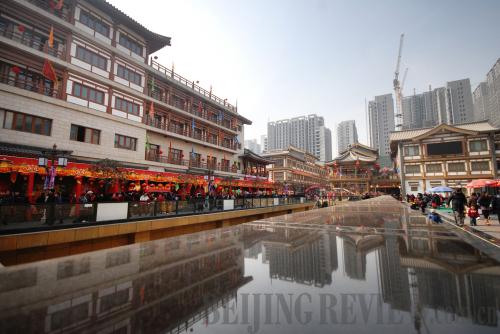 |
|
ANCIENT-STYLE ARCHITECTURE: Buildings modeled on Tang Dynasty architecture are part of the Tang West Market (WEI YAO) |
The latest excavation of the site was conducted in 2006, when an expert team led by An Jiayao, an archaeologist at the Institute of Archaeology under the Chinese Academy of Social Sciences, was invited to lead the research at a site that a company planned to do real estate development. After three months of research, archaeologists found many rare relics of the Tang Dynasty at the site, such as a small stone bridge, a waterway, tracks of wagon wheels, tools used in workshops and Tang Dynasty coins.
Understanding the archaeological significance of the site, the developer, Xi'an Tang West Market Culture Industry Investment Co. Ltd., decided to give up its former plan to build a 50,000-square-meter business facility. To better preserve the site, the company invested 320 million yuan ($47.76 million) to build a museum to preserve the site and exhibit artifacts found there.
"Modern houses can be built tomorrow, but protecting historic sites and the cultural heritage left by our ancestors should be done today," Lu Jianzhong, Board Chairman of Xi'an Tang West Market Culture Industry Investment Co. Ltd., told Beijing Review.
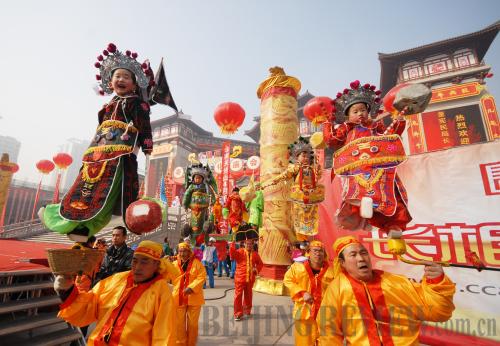 |
|
CHILDREN PERFORMERS: A traditional folk performance is staged at the temple fair of the Tang West Market during the Spring Festival holiday in early February (WEI YAO) |
It was the first time a private company invested in a museum in China to preserve a historic site, thus showing the entrepreneur's strong sense of social responsibility. Formerly, preservation of historic sites in China was solely the province of governmental bodies. Little private capital flowed into such investment, since there were no foreseeable economic returns.
The museum, called the Tang West Market Museum, covers more than 13,000 square meters. The company invited archaeological experts to supervise the preservation of relics and the creation of exhibits, as well as work related to the research and operation of the museum.
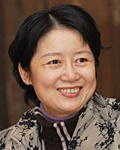 |
|
Wang Bin, Curator of the Tang West Market Museum (WEI YAO) | "Relic preservation at our museum meets national standards. We employ professional archaeological personnel to participate in this work, in order to ensure the preservation of the relics," said Wang Bin, Curator of the Tang West Market Museum and former Deputy Curator of the Shaanxi History Museum.
"We have a collection of about 20,000 cultural relics. A large portion of the exhibits in the museum are relics found at the site, which have all been registered with the government's cultural relics department. The findings from the site are ranked as national-level cultural relics and belong to the country. Our museum is just in charge of exhibiting them to the public," the senior historian said.
The unique aspect of the museum is how it displays the original state of the site. The site preservation area, which is about 2,500 square meters, features a thick glass floor. Walking on the glass floor, visitors can clearly see the wagon wheel tracks, waterway, bridge and bricks of the West Market during its golden era, more than 1,000 years ago.
Besides archaeological findings, the museum also exhibits related displays from collectors and introduces local art and folk customs of Xi'an. It presents a broad picture of the city's history, culture and society, both past and present.
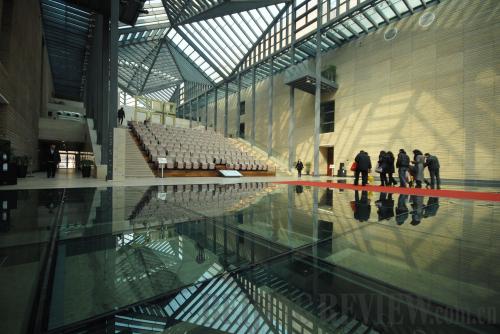 |
|
UNDERSTANDING HISTORY: Visitors view relics excavated from the site of the ancient West Market at the Tang West Market Museum. The relics are preserved intact under a glass floor (WEI YAO) |
Since the museum opened on April 7, 2010, it has aroused increasing attention from the public, and the number of visitors even reached 1,800 a day, said Wang. "It was really a big number for a private museum."
Revival
But creating this museum was not easy for Lu and his company. Cherishing a dream of restoring the historical West Market, he persuaded two business partners to withdraw from the original real estate project on the site of the ancient West Market. To accomplish this, Lu had to pay these companies two times their original investment.
With an investment of 4.5 billion yuan ($671.64 million), development of the Tang West Market, a grand project to partially rebuild the West Market on its former site, started in 2001. In addition to the museum, the architectural complex also includes exhibition halls, a performing center, an antique market, an exhibition hall for intangible cultural heritage items of Shaanxi Province, a shopping center, a high-class business club and a special street for displaying arts and goods from other countries along the Silk Road.
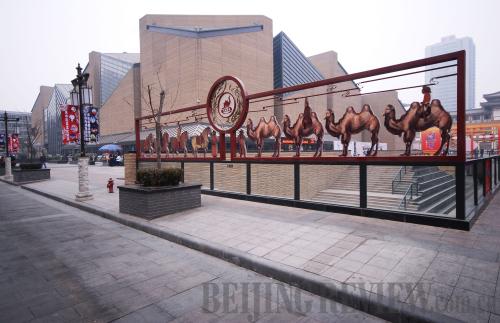 |
|
HISTORY AND ART: Images of a Silk Road caravan adorn a modern work of art close to the Tang West Market Museum (WEI YAO) |
"Most parts of the complex are open to the public. We are now working on the construction of the street for foreign arts and goods, which will be another highlight of the Tang West Market," said Lu.
According to Lu, when the street is fully completed, it will be an important exhibition center for architecture from other Silk Road countries and will also serve as a center for trading various foodstuffs and goods from those countries. "Walking along the street, Chinese visitors can appreciate the cultural essence of other Silk Road countries without having to go there," he said.
"We will invite people from those countries to operate shops in the street and hope more foreign friends will come here to learn more about the city and make their own fortunes here," said Lu. "Such commercial and cultural exchange between Chinese and foreign people was done more than 1,000 years ago, and it will flourish again today."
|
